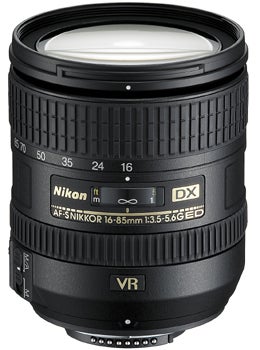With a second-generation VR system and handy focal range, is this the ideal all-purpose lens for Nikon DX-format bodies?
Nikon AF-S 16-85mm f/3.5-5.6G ED VR DX Review
The lens is very compact, protruding less than 90mm from the front of the camera body. The zoom ring is at the front and offers just the right amount of resistance; the manual-focus ring is towards the rear, behind the focused-distance window, and verges on being slightly too narrow for comfortable use. Manual intervention is available in AF mode if required.
At the back of the lens are three sliders that select focus mode, VR off/on and VR mode. The first of these falls readily to hand, the second less so and the third is really quite awkward to reach when the lens is in use.
Nikon includes a petal-type lens hood with the 16-85mm zoom but this cannot be left reversed over the lens because it obstructs the zoom ring, especially at focal-lengths below 35mm. If I had been designing the lens I would have put the focused-distance window at the front and moved the zoom ring back so that the lens hood did not have to be removed on occasions when the picture-taking situation demanded an instant response.
Field testing confirms Nikon’s assertion that this is ‘an ideal lens for today’s high-resolution SLRs’. As the MTF graph on the right shows, the curves for all four tested focal-lengths remain above the critical 0.25 cycles-per-pixel level from maximum aperture down to f/16. Unfortunately, because of its variable aperture, the smallest f-stop decreases from f/22 at 16mm to f/36 at 85mm and the corresponding resolution figures plummet. This is not unusual but it does mean that anything below f/22 should be avoided if at all possible.
Chromatic aberration is almost non-existent and can only be really detected as a trace effect in pictures captured at the 16mm setting. Furthermore, there’s absolutely no denying that Nikon’s VR system works really well in this lens so camera-shake ought to be a thing of the past as well.






